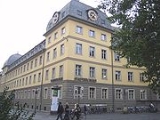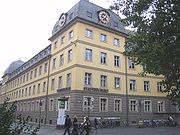
German Bestelmeyer
Encyclopedia
German Bestelmeyer was a German
architect
, university lecturer, and proponent of Nazi architecture
.
, where he was a student of Friedrich von Thiersch.
During the Third Reich mere opposition to Bauhaus
architecture was enough to gain official approval for almost any architect, as with Bestelmeyer. A member of the Munich School to which Paul Troost
also belonged, he had been trained under Theodor Fischer
. He was praised by Paul Schultze-Naumburg
in a lecture in 1931, because he aligned himself with supporters of traditional styles. In 1934, he became head of the Munich Academy of Art to which he enlisted Alexander von Senger
, the passionate opponent of Bolshevik
architecture. Later, Bestelmeyer designed the Luftwaffe
office building on the Prinzregentenstraße in Munich
. This traditional building and his other works were singled out for praise in the later 1930s. An article he wrote in 1934 sums up his ideas and probably drew the approval of Nazis. Admiring Senger's criticism of Le Corbusier
, he found that, in the 1920s architecture was petrifying into mere architectural technology, creating soulless buildings. The flat roof, he said was simply not practical for Germany's climate. His 1928 alliance with Schultze-Naumburg, Schmittehenner and others into "The Block", a group of architects determined to combat the experiment of the Bauhaus
, made him acceptable.

Germany
Germany , officially the Federal Republic of Germany , is a federal parliamentary republic in Europe. The country consists of 16 states while the capital and largest city is Berlin. Germany covers an area of 357,021 km2 and has a largely temperate seasonal climate...
architect
Architect
An architect is a person trained in the planning, design and oversight of the construction of buildings. To practice architecture means to offer or render services in connection with the design and construction of a building, or group of buildings and the space within the site surrounding the...
, university lecturer, and proponent of Nazi architecture
Nazi architecture
Nazi architecture was an architectural plan which played a role in the Nazi party's plans to create a cultural and spiritual rebirth in Germany as part of the Third Reich....
.
Life
From 1893 to 1897 Bestelmeyer studied architecture at the Technical University of MunichTechnical University of Munich
The Technische Universität München is a research university with campuses in Munich, Garching, and Weihenstephan...
, where he was a student of Friedrich von Thiersch.
During the Third Reich mere opposition to Bauhaus
Bauhaus
', commonly known simply as Bauhaus, was a school in Germany that combined crafts and the fine arts, and was famous for the approach to design that it publicized and taught. It operated from 1919 to 1933. At that time the German term stood for "School of Building".The Bauhaus school was founded by...
architecture was enough to gain official approval for almost any architect, as with Bestelmeyer. A member of the Munich School to which Paul Troost
Paul Troost
Paul Ludwig Troost , born in Elberfeld, was a German architect. An extremely tall, spare-looking, reserved Westphalian with a close-shaven head, Troost belonged to a school of architects, Peter Behrens and Walter Gropius who, even before 1914, reacted sharply against the highly ornamental...
also belonged, he had been trained under Theodor Fischer
Theodor Fischer
Theodor Fischer was a German architect and teacher.Fischer planned public housing projects for the city of Munich beginning in 1893. He was the joint founder and first chairman of the Deutscher Werkbund , as well as member of the German version of the Garden city movement...
. He was praised by Paul Schultze-Naumburg
Paul Schultze-Naumburg
Paul Schultze-Naumburg was a Nazi architect and one of Nazi Germany's most vocal political critics of modern architecture...
in a lecture in 1931, because he aligned himself with supporters of traditional styles. In 1934, he became head of the Munich Academy of Art to which he enlisted Alexander von Senger
Alexander von Senger
Alexander von Senger, Swiss architect and architectural theorist.Hugues Rodolphe Alexandre von Senger was born in Geneva...
, the passionate opponent of Bolshevik
Bolshevik
The Bolsheviks, originally also Bolshevists , derived from bol'shinstvo, "majority") were a faction of the Marxist Russian Social Democratic Labour Party which split apart from the Menshevik faction at the Second Party Congress in 1903....
architecture. Later, Bestelmeyer designed the Luftwaffe
Luftwaffe
Luftwaffe is a generic German term for an air force. It is also the official name for two of the four historic German air forces, the Wehrmacht air arm founded in 1935 and disbanded in 1946; and the current Bundeswehr air arm founded in 1956....
office building on the Prinzregentenstraße in Munich
Munich
Munich The city's motto is "" . Before 2006, it was "Weltstadt mit Herz" . Its native name, , is derived from the Old High German Munichen, meaning "by the monks' place". The city's name derives from the monks of the Benedictine order who founded the city; hence the monk depicted on the city's coat...
. This traditional building and his other works were singled out for praise in the later 1930s. An article he wrote in 1934 sums up his ideas and probably drew the approval of Nazis. Admiring Senger's criticism of Le Corbusier
Le Corbusier
Charles-Édouard Jeanneret, better known as Le Corbusier , was a Swiss-born French architect, designer, urbanist, writer and painter, famous for being one of the pioneers of what now is called modern architecture. He was born in Switzerland and became a French citizen in 1930...
, he found that, in the 1920s architecture was petrifying into mere architectural technology, creating soulless buildings. The flat roof, he said was simply not practical for Germany's climate. His 1928 alliance with Schultze-Naumburg, Schmittehenner and others into "The Block", a group of architects determined to combat the experiment of the Bauhaus
Bauhaus
', commonly known simply as Bauhaus, was a school in Germany that combined crafts and the fine arts, and was famous for the approach to design that it publicized and taught. It operated from 1919 to 1933. At that time the German term stood for "School of Building".The Bauhaus school was founded by...
, made him acceptable.
Works (selected)

- Extension Building of University of Munich (1906-1909)
- Adolphus Busch HallAdolphus Busch HallAdolphus Busch Hall is a Harvard University building located at 27 Kirkland Street in Cambridge, Massachusetts. It is named for brewer and philanthropist Adolphus Busch, former president of the Anheuser-Busch company, who contributed $265,000 to its building fund.The hall was designed by architect...
at Harvard UniversityHarvard UniversityHarvard University is a private Ivy League university located in Cambridge, Massachusetts, United States, established in 1636 by the Massachusetts legislature. Harvard is the oldest institution of higher learning in the United States and the first corporation chartered in the country...
, Design (1910) - Schlosshotel im Grunewald in Berlin-Grunewald (1911-1914), which was built as a villa for Walter von Pannwitz
- Life Insurance Bank "Arminia" in Munich (1914-1916)
- Old Stadthaus in BonnBonnBonn is the 19th largest city in Germany. Located in the Cologne/Bonn Region, about 25 kilometres south of Cologne on the river Rhine in the State of North Rhine-Westphalia, it was the capital of West Germany from 1949 to 1990 and the official seat of government of united Germany from 1990 to 1999....
(1922) - Administration Building in BerlinBerlinBerlin is the capital city of Germany and is one of the 16 states of Germany. With a population of 3.45 million people, Berlin is Germany's largest city. It is the second most populous city proper and the seventh most populous urban area in the European Union...
(1920-1923) - Krochhochhaus at the Augustus Plaza in LeipzigLeipzigLeipzig Leipzig has always been a trade city, situated during the time of the Holy Roman Empire at the intersection of the Via Regia and Via Imperii, two important trade routes. At one time, Leipzig was one of the major European centres of learning and culture in fields such as music and publishing...
(1927/1928) - Evangelical Lutheran Pfarr Church "Christchurch" in Neuburg an der DonauNeuburg an der DonauNeuburg an der Donau, literally Neuburg on the Danube River, is a town which is the capital of the Neuburg-Schrobenhausen district in the state of Bavaria in Germany.-Divisions:The municipality has 16 divisions:-History:...
(1927 bis 1930) - Germanisches NationalmuseumGermanisches NationalmuseumThe Germanisches Nationalmuseum is a museum in Nuremberg, Germany. Founded in 1852, houses a large collection of items relating to German culture and art extending from prehistoric times through to the present day...
, Reconstruction and Extension Building (1913 bis 1919) - Extension Building of Technical University of MunichTechnical University of MunichThe Technische Universität München is a research university with campuses in Munich, Garching, and Weihenstephan...
(1923-1926) - Study Building and Congress Center of the Deutschen MuseumDeutsches MuseumThe Deutsches Museum in Munich, Germany, is the world's largest museum of technology and science, with approximately 1.5 million visitors per year and about 28,000 exhibited objects from 50 fields of science and technology. The museum was founded on June 28, 1903, at a meeting of the Association...
in Munich (1928-1932) - Air Commandos on the Prinzregenten Street in Munich (1935-1936)
- Evangelical Lutheran Resurrection Church in Munich-Westend Gollier Street 55 (Opening Ceremony 1931)
- Evangelical Lutheran Stephanus Church in Munich Neuhausen-Nymphenburg Nibelungen Street 51 (Opening Ceremony 1938)

